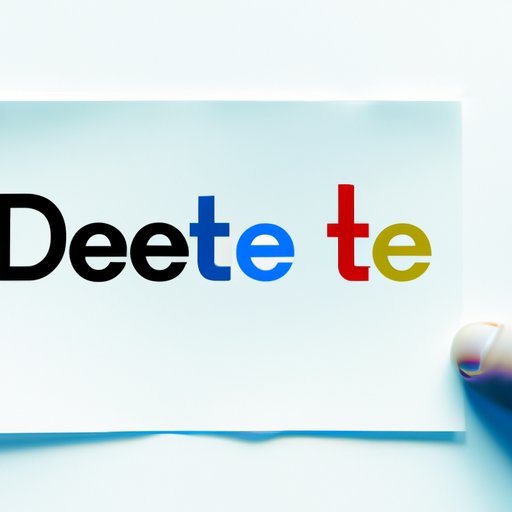
Introduction
Deleting a Google account may seem like a daunting task, but it can be an important step towards increased privacy and security. This comprehensive guide will walk you through the process of deleting your Google account, as well as explore the benefits of doing so and provide alternative services to consider.
Step-by-Step Guide to Deleting a Google Account
First, log in to your Google account and navigate to the account preferences page.
Scroll down to find the option to “Delete your account or services” and click it. From there, follow the prompts to confirm your decision to delete your account and understand the implications of doing so.
It’s important to note that deleting your Google account will also delete all of your data within Google’s services, including Gmail, Drive, and Calendar.

Benefits of Deleting a Google Account
There are many reasons why someone may want to delete their Google account. For one, there is a growing concern over data privacy, and many users feel uncomfortable with the amount of personal information Google has about them. By deleting your account, you can take back control of your data and limit the amount of personal information that can be accessed through Google.
Another benefit to deleting your Google account is increased security. By removing your data from Google, you reduce the chances of your information being compromised in a data breach or hack. Additionally, if you no longer use Google’s services, deleting your account can help simplify your digital footprint and reduce your risk of identity theft.
There are also certain situations where deleting your Google account may be necessary, such as if you are closing a business or changing your online identity. In these cases, deleting your account can help prevent confusion or unauthorized access to your information.
Using Alternative Services
If you decide to delete your Google account, there are a variety of alternative services to consider. For example, there are privacy-focused search engines like DuckDuckGo and StartPage that do not track your searches or store your data. Additionally, there are email providers like ProtonMail and Tutanota that offer end-to-end encryption to protect your communications.
Here is a comparison chart of popular alternatives:
| Service | Features | Price |
|---|---|---|
| DuckDuckGo | Anonymous searches, no personal data tracking | Free |
| StartPage | Private searches, no personal data tracking, Google results | Free or $9.99/month for extra features |
| ProtonMail | End-to-end encrypted email, self-destructing messages | Free or $5-$8/month for extra features |
| Tutanota | End-to-end encrypted email, calendar, and contacts | Free or $1.20-$6/month for extra features |
Troubleshooting Common Issues
One common issue users may face when trying to delete their Google account is not being able to access their account. In this case, Google provides a recovery process that can help you regain access to your account, which you can then delete as outlined in step two. Another issue may be associated with losing important data after deleting your Google account. To avoid facing such issues, it is recommended to download important data beforehand.
Comparing Google to Other Tech Giants
While Google is known for its data collection practices, other tech giants like Apple and Microsoft also collect and store personal information. The difference is that both Apple and Microsoft prioritize user privacy and have implemented stronger privacy policies and data protection measures compared to Google. For example, Apple has integrated end-to-end encryption across its devices and services, while Microsoft allows users to control their data and decide how it’s used.
By deleting your Google account, you can help protect your privacy and take control of your personal information. Consider alternative services that prioritize privacy and data protection to further safeguard your information.
Conclusion
Deleting a Google account may seem daunting, but it is an important step towards increased privacy and security. By following the step-by-step guide outlined in this article, you can take back control of your personal information and reduce your risk of data breaches and identity theft. Consider alternative services that prioritize privacy and data protection, and encourage others to take action to protect their privacy online as well.




